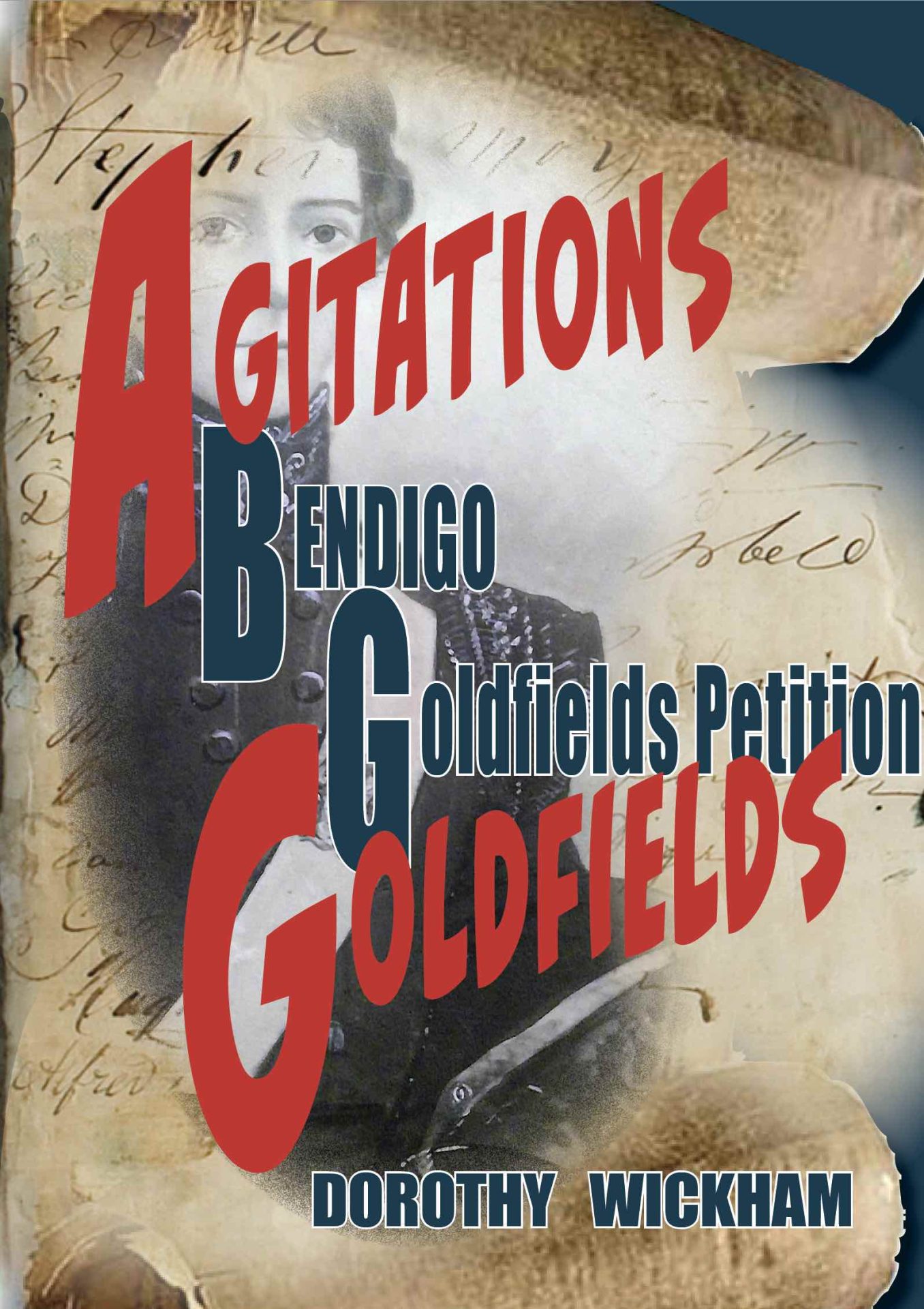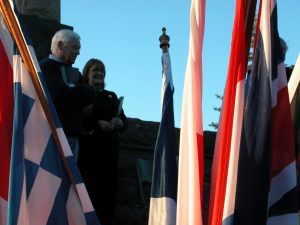The importance of agitations, disturbances and events on the Australian goldfields is becoming more evident now, as new comparative information and global connections are uncovered. The formation of the Red Ribbon Movement and the Ballarat Reform League that ultimately led to the Eureka Affair, are particularly important, not only on a parochial level but on a national and international scale.

1853 Bendigo Goldfields Petition

http://www.eurekapedia.org/Bendigo_Goldfields_Petition
Around 5,000 names have been added to the Eureka Wiki. These are from the 1853 Bendigo Goldfields Petition, signed by men (and two women) on the Victorian goldfields in mid-1853. Some have been easy to read, while others are almost impossible to decipher.
From 1851 near Castlemaine agitations erupted on the Victorian goldfields. There was unrest at the Ovens, Bendigo, Ballarat and other diggings. I wrote Bendigo Goldfields Petition to examine the agitations that culminated in December 1854 at the Eureka Lead in Ballarat East. Rather than isolated local events these agitations were part of a global effort by men and women in a quest for equality, liberty and freedom.
Eureka - 3 December 1854
On 29 November 1854 the second ‘Monster Meeting’ was held on Bakery Hill, Ballarat East. This was only four days before the battle at the Eureka Stockade. A flag with white stars on a dark blue background was flown on an eighty foot pole at Bakery Hill. After Peter Lalor took the orator's stump, he urged the miners to burn their licences in protest of the high taxes the government was imposing on them. The diggers knelt, and with heads uncovered pointed to the Eureka Flag, the Flag of the Southern Cross, and solemnly swore the Diggers' Oath.
We swear by the Southern Cross to stand truly by each other and fight to defend our rights and liberties.
Information about Eureka including pre and post Eureka (with commemorative information for each year), plus 1000s of biographies and commentaries, can be found on the Eurekapedia Wiki.This platform was created by Clare Gervasoni and Dorothy Wickham, kindly hosted by the Ballarat Reform League Incorporated, with assistance from the Vera Moore Foundation. It comprises over 7,351 pages with 1000s of references. Launched in 2014 it has attracted over 10 million views, showing its popularity amongst researchers, historians, and educators.
EUREKA CHARTER
Often known as the Ballarat Reform League Charter this handwritten document consists of four pages. The original document was presented to Governor Hotham on 27 November 1854, six days before the Eureka Stockade battle.
The original has not survived, and its format is unknown. The surviving copy is a clerk's copy of the original Charter, and is held by the Public Records Office, Victoria. The Charter is handwritten on watermarked government blue paper, folded into four foolscap-sized pages containing the text of the Charter. The copy was created for administrative purposes by the Governor's office at the time it was received by Governor Hotham. It has markings on it indicating it was created by the Governor's office and that it was the copy read by Governor Hotham.
The Ballarat Reform League Charter was democratic in tone, likened to the American Declaration of Independence of 4 July 1776, and the People's Charter drawn up by British Chartists in May 1838.
The Ballarat Reform League Charter was adopted by over 10,000 miners and storekeepers on Bakery Hill on the Ballarat goldfields on 11 November 1854, establishing its authority to represent the opinion of the majority of the adult population of Ballarat.
http://eurekapedia.org/Charter_of_Rights
COMMEMORATION
On 3 December 1855, the first anniversary of the battle of Eureka, Raffaello Carboni sat at the Diggers' burial site in the Ballarat Old Cemetery giving readings from his book Eureka Stockade. Printed by J.P. Atkinson and Co., the book was 126 pages in length and had green printed wrappers. He sold copies to passers by.
The Age editorial ran a piece about Eureka.
When peace shall lie once more regained, and there shall be time for deliberate judgement, the citizens will reckon with the Government. Meantime, they will not pledge themselves to support it; and they will not organize themselves into bodies for the purpose of filling the place of that expensive military force, which should never have been sent out of Melbourne. [We] do not sympathise with revolt; but neither do [we] sympathise with injustice and coercion. [We] will not fight for the diggers nor will [we] fight for the Government.
The Age, 5 December 1855.
http://eurekapedia.org/Commemoration
EUREKA DAWN ORATION
 One hundred and fifty-one years ago the people of Eureka fought for their democratic rights and freedoms. They objected to the unjust administration of the goldfields such as the tax on work before any work was even undertaken. I would like to take this opportunity today to acknowledge the part of Henry Seekamp, the editor and owner of The Ballarat Times, who married the actress Clara du Val in 1854 at Ballarat. Seekamp wrote that the disturbances at Eureka were only the 'trunk of the elephant', meaning of course, that there was much more under the surface than was visible. The editorials in his paper were full of energetic criticisms. He was charged and gaoled for Seditious Libel the day after the Eureka battle. The newspaper carried the caption that the editor had been arrested.
One hundred and fifty-one years ago the people of Eureka fought for their democratic rights and freedoms. They objected to the unjust administration of the goldfields such as the tax on work before any work was even undertaken. I would like to take this opportunity today to acknowledge the part of Henry Seekamp, the editor and owner of The Ballarat Times, who married the actress Clara du Val in 1854 at Ballarat. Seekamp wrote that the disturbances at Eureka were only the 'trunk of the elephant', meaning of course, that there was much more under the surface than was visible. The editorials in his paper were full of energetic criticisms. He was charged and gaoled for Seditious Libel the day after the Eureka battle. The newspaper carried the caption that the editor had been arrested.
...
Under current Australian law it is an offence to engage in Seditious Intention, Enterprises, or Words. The current law specifies that any person who, with the intention of causing violence or creating public disorder or a public disturbance, writes, prints, utters or publishes any seditious words, shall be guilty of an indictable offence punishable by imprisonment for three years.
...
Seekamp was a slight, sickly man who fought with the pen rather than the sword. His editorials were fiery and contentious, filled with the sentiments of English Chartists such as J R Stephens or Thomas Carlyle. John Basson Humffray and Henry Holyoake, two well-known Eureka identities, shared the same Chartist ideals, sentiments that were echoed in the Charter of the Ballarat Reform League.
...
The Ballarat Reform League, in essence, sought a democratic and egalitarian society. It sought a reduction in licence fees, a say in the parliament, and a just administration of the goldfields, as well as other reforms, for the everyday man, woman and child. These points were echoed in Seekamp’s editorials. He condemned the administration of the Ballarat goldfields.
The Resident Commissioner of the Goldfields Robert Rede sent a copy of The Ballarat Times to the Chief Commissioner in Melbourne writing: ‘I enclose you a copy of The Ballarat Times which points to Wednesday as a day on which something will occur. I request that the leading article may be laid before the Attorney General for his opinion as it appears to me highly seditious and under existing circumstances, such language should be stopped if possible’. Not long after Rede’s protesting letter the battle of Eureka occurred.
Afterwards around 120 men were arrested and 13 were charged with High Treason. Only Seekamp was charged with Sedition, convicted of Seditious Libel on 23 January 1855, and sentenced to 6 months gaol.
Clara Seekamp ran the paper in her husband’s absence. She was possibly the first female editor in Australia. Her editorial style remained steadfast and continued the ideas of the Ballarat Reform League.
The Argus expressed the sentiment on 31 January 1855 that it hoped that a lenient sentence would be given to Mr Seekamp to enable his quick return ‘to his editorial duties’. Clara’s editorials were described by the Argus on at least one occasion, as outspoken, startling in tone, and liberal and energetic in their use of words such as ‘sedition’, ‘liberty’ and ‘oppression’.
The people at Eureka 151 years ago fought for equality, liberty and freedom. These are ideals that should never be eroded. As a tribute to the people of Eureka we should always be vigilant to ensure for everyone the right to freedom.
Long Live the Spirit of Eureka!
Presented by Dorothy Wickham,
6 am. Sunday 4 December, 2005
Susan Kruss has written a poem about Clara Seekamp. She has vocalised what Clara’s thoughts at the time of Eureka may have been. I would like to share an excerpt with you.
I got such a shock to see bodies
not acting but real dead eyes
looking up so fixedly
I had not imagined it being so awful
wives sweethearts children cried over them
Henry began the Stockade edition
We knew they’d arrest him for saying
that diggers have rights next morning
they seized him and took him away
I’m sure I’ll never forget what I saw
But I’ll see them right yet I’ll take on
being editor just as Henry would do I will
mention ‘sedition’ – the charge laid against him-
‘liberty’ and ‘oppression’ will be in each edition
the voice of the people cannot be silenced
by silencing one for the press is the voice
of the people and will not be silenced while I can
go on though I’m sure there’ll be those
shocked by a woman as editor who’ll oppose
every word that I write with some scorn
I see in The Argus this morning they hope that
my husband will soon be released and relieve
the goldfields of Ballarat from the dangerous
influence of a free press petticoat government.
Susan Kruss